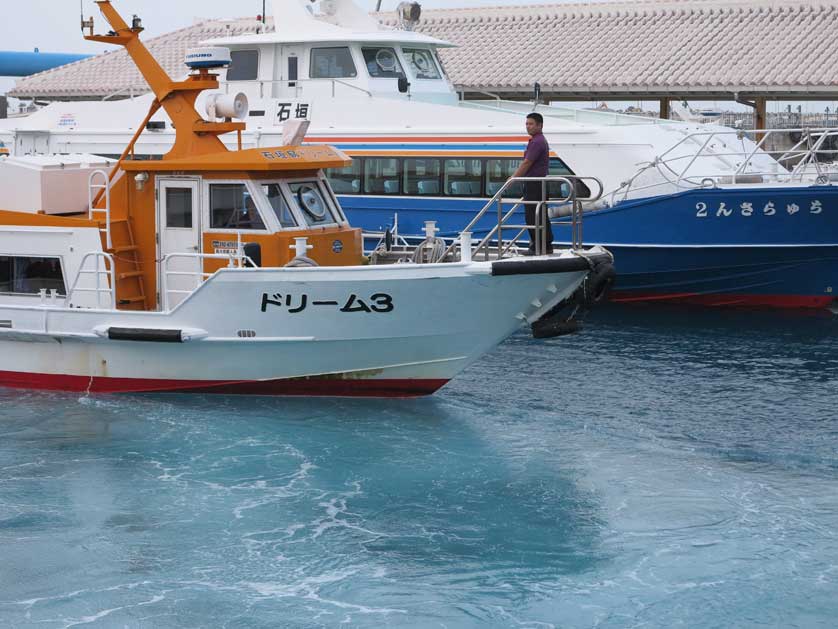Ferry Travel in Japan
Japan Ferry Travel. The ferry is one of the most underutilized forms of transport in Japan. However, being an archipelago, Japan has an extensive ferry network. Read about how enjoyable and economic a means of transport the ferry can be in Japan.
Using the ferry in Japan
Owen Grieb

Is the serenity of distant prefectures beckoning you away from your caffeine-fueled urban hyper-lifestyle? Want a relaxing vacation without squandering too many hard-earned yen? Consider letting yourself in on one of Japan's biggest travel secrets - the nation's convenient and inexpensive ferry system.
Japan's ferry system is extensive, connecting Japan's four main islands: Honshu, Kyushu, Shikoku, Hokkaido - and going even as far as Okinawa. There is an international option too with a ferry service plying Pusan (Busan) and Fukuoka (for those looking to renew their visas or shop cheaply). There was also a connection with Taiwan via Osaka and Okinawa, but this is now longer operational.
The ferry brings close places even closer (like connecting eastern Kyushu with western Shikoku in a short puddle-hop) and can make longer trips both more interesting and relaxing than by plane. If time is your concern, then the ferry's not going to be as quick as an airplane, but - with better flotation than a car - is definitely better designed for island-hopping, and much cheaper than an airplane.
As a government-employed English teacher in Oita prefecture (home of the famous onsen-resorts of Beppu and Yufuin), I was required to travel several times to Kyoto, Osaka, and Kobe to attend teaching-related events. I discovered that using a ferry was not only more comfortable and interesting than flying, but also much less expensive, the one-way fare coming to between 5,000 and 10,000 yen, depending on the destination. Wishing to minimize travel expenses and so maximize nightlife enjoyment, a friend and I decided to blaze unfamilar trails and take the Diamond Ferry (operated by the Kanki Kisen group) from Beppu to Osaka.
 Ishigaki Island Express Ferry, Yaeyama, Okinawa
Ishigaki Island Express Ferry, Yaeyama, Okinawa
 Jetfoil to Sado-ga-shima by boat from Niigata Ferry Terminal
Jetfoil to Sado-ga-shima by boat from Niigata Ferry Terminal Jetfoil and car ferry are the two options for getting to Sado-ga-shima by boat from Niigata Ferry Terminal
Jetfoil and car ferry are the two options for getting to Sado-ga-shima by boat from Niigata Ferry Terminal
Buying A Ferry Ticket
Buying a ferry ticket was simple. We arrived at the terminal in Beppu about an hour before the ferry was scheduled to leave, parked our cars in a long-term parking lot for around 500 yen a day and bought a ticket at the terminal. Although we didn't elect to do so, many other ferry-goers were taking their automobiles with them (for around 10,000 yen), and before boarding we watched the blue-uniformed workers single-mindedly driving passengers' cars into the belly of the vessel.
Several room options were available, and as single men in Japan tend to do, we opted for the cheapest option: a tatami common-room in which 50 or so people sleep side-by-side. Clean futons and sheets were provided by the ferry, as were bathrobes for the on board Japanese-style bath (more later!). Whereas a ride in steerage might be a noisy, smelly affair in a country with less well-behaved citizens, our fellow Japan passengers were, needless to say, well-behaved and quiet. Most fellow passengers had passed out by ten o'clock (about two hours after having embarked) and, out of sight, passed virtually out of mind.
For couples, I would recommend more private accommodations. Several options are available - from a more expensive private room to a less private 6-passenger room with curtained off beds. If you can speak Japanese, it pays to ask whether any of the larger 12-person rooms are empty.
Once, on a Beppu-Osaka trip with my significant other I managed to secure an empty 12-person room for considerably less than what it would have cost for the private room. We saved around 5,000 yen in the process while still enjoying our privacy.
 Ishigaki Island Express Ferries, Yaeyama, Okinawa
Ishigaki Island Express Ferries, Yaeyama, Okinawa


Entertainment
After claiming a futon and leaving our bags in the tatami room, my friend and I proceeded to the cafeteria, ordered a beer, and sat down to enjoy a light meal of sushi and salad. The cafeteria was fully equipped and one could order ramen, sashimi, soup, sushi, and a plethora of other Japanese foods.
Although a little expensive, the meal was refreshing. Rubbing elbows with fellow travelers in Japan is something which ferry-travel makes possible, and after eating and knocking back a few cold ones, we (as gaijin will) began to walk around and chat with Japanese patrons. We met fishermen from Hokkaido, a group of chuugakusei (middle school students) eager to practice their English, as well as a Korean businessman who invited us back to a large washitsu (Japanese-style room) which his company had reserved for him.
He and other members of his company were traveling throughout Japan on vacation and, having just enjoyed the onsens of Beppu, were now on their way to Osaka. They, too, were eager to try out their English and, as fellow "gaijin", were interested to meet other foreigners in Japan. The pleasure of communion was enhanced by the beer and Korean food they kindly laid on.
Picturing the alternative: several hundred dollars-worth of cramped airplane and hamster-cage business hotel, I knew that going for the ferry option had been the right decision. We would be arriving at Osaka in the morning bathed, fed, refreshed, and several friends richer, all for under 10,000 yen.
Bathed, fed, refreshed ... ah yes, bathed! The large Japanese-style bath was one of the highlights of the trip (and the bathroom specifically the sinks - the only place we could find electrical outlets to recharge our mobile phones). As any foreigner grown comfortable with communal nakedness knows, one of Japan's finest customs is its bathing. The ferry's Japanese-style bath included a medium-sized communal room for scrubbing down as well as a huge bath. At around 11:00 p.m., after saying good-bye to the Korean business people, my friend and I decided to hit the tub, taking a good half hour to let the steam and heat work out the kinks. Surprisingly few people were using itand, though making new friends can be fun, having a long silent relax was also nice.
Back in our clothes and ready for bed, we couldn't resist heading to the cafeteria for one last beer, which we took out onto the top deck and sipped, watching the brightly-lit cities skirting the inland sea slip by into the night. It was truly a sight to remember, and one more inspired reason to sidestep the stress - not to mention the expense - of milling airports, cramped airplanes, and chicken coop business hotels.
Sleeping on a Japanese Ferry
Many soundly slept hours later, we woke to the sound of chattering fellow travellers folding up their bedding and preparing to disembark. It was 8:00 a.m., and the day was just starting in Osaka. We grabbed our stuff and got off the ferry, ready to take on the town.
I admit, sleeping in a crowded room may not be everyone's idea of comfort, but the perks of ferry travel are nonetheless real. If traveling with a spouse or other loved one, communal sleeping arrangements might not be ideal; but on the plus side are the bath and the fun of meeting other travelers, not to mention the views from the upper-deck. And anyway, most of your time in the communal room will be spent sleeping - meaning you will barely register your fellow passengers. For those prone to seasickness, take heart. Ferries are not your typical rocking-boat affairs but, being almost cruise ship size, are remarkable free of roll and yaw. In fact, it was next to impossible to tell that the ferry was moving at all once it left port until it docked.
So far, I've used the ferry from Kyushu to Osaka, Kyoto, and Yakushima. I remain a diehard fan. The ferry to Beppu from Osaka or Kobe is the perfect getaway vessel for stressed city-dwellers seeking a relaxing onsen vacation in the country.
Talk to your local travel agent to find out more. JTB (Japan Travel Bureau) can be contacted on 03-3276-7777.
Find out more about the ferry in Travel within Japan.
A large-scale interactive ferry-travel map in Japanese is available here (Japanese language only).
The Japan Ferry Pass 21 offers 6 journeys on 14 routes over 21 days for 21,000 yen.
Happy sailing!
Text by Owen Grieb
More information on Japan ferries









